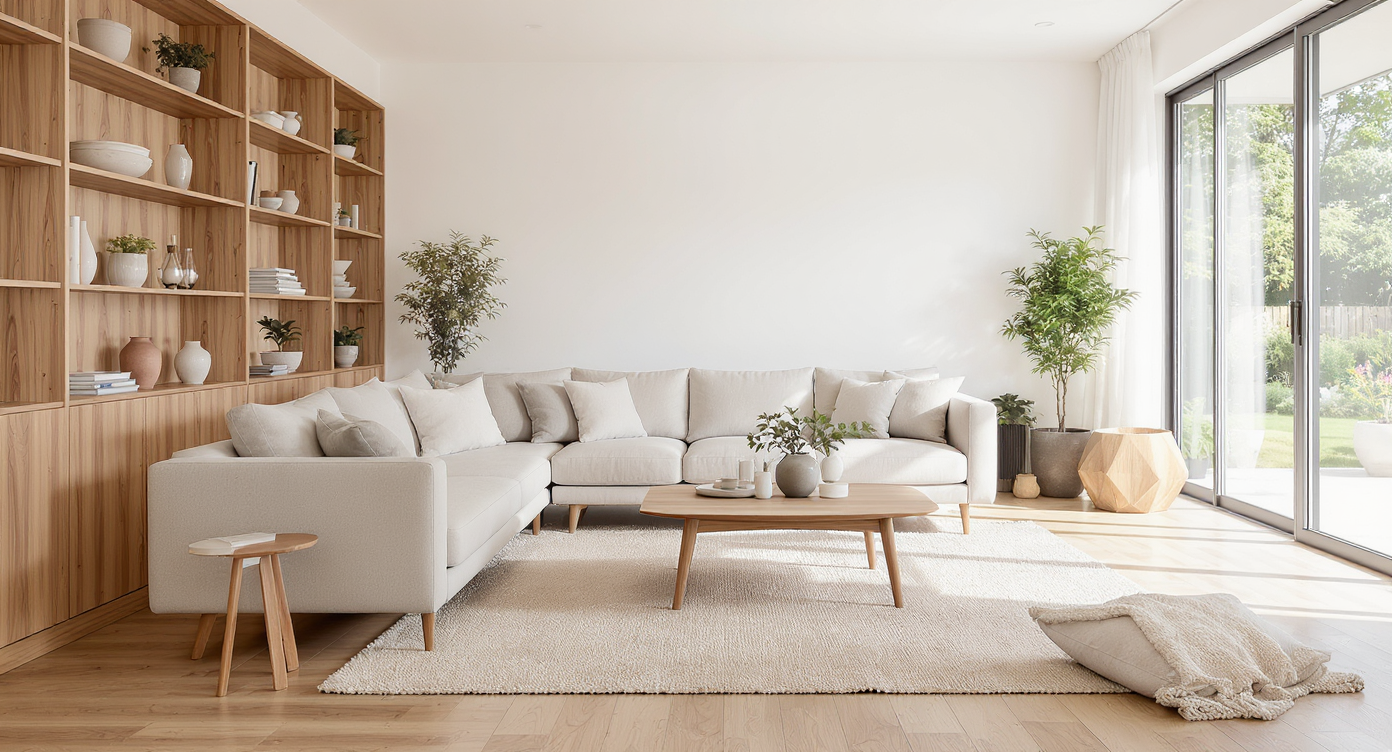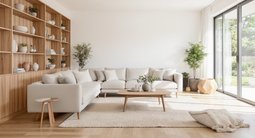TL;DR
Use this room-by-room furniture layout guide to match sofa size, dining table dimensions, and storage to your square footage. We’ll cover clearances, ergonomic heights, and style mixing so you can avoid costly returns and get a layout that works. Includes how to choose dining table size for 6 and a rug size guide for living rooms with a sectional.
Furniture Layout 101: The Exact Measurements for Sofas, Rugs, and Dining Tables

Smart layout diagram illustrating key sofa sizes and clearances to create smooth, livable spaces.
Here’s the thing: most layout mistakes come from buying a sofa or dining table before measuring and mapping clearances. The right sofa size, rug size, and storage plan turn tight rooms into smooth, livable spaces. What most people miss is the math. You need walkways, reach zones, and eye-level viewing angles just as much as you need mid-century furniture lines or a Scandinavian style palette. This guide blends style selection with exact measurements so every piece looks good and works hard. Quick check: if you’re debating mid-century vs Scandinavian, choosing a bed frame, or asking how to choose dining table size for 6, you’re in the right place. Let’s layout, then layer.
Core Question: What Furniture Fits My Room?
Start with clearances: keep 30–36 in paths for circulation and at least 18 in of knee space at seating, then scale sofa and tables so nothing blocks door swings or windows.
Measure the envelope first. Record length × width, ceiling height, door and closet swings, window sill heights, and outlet locations. Sketch major pieces to scale on graph paper or in a room planner to test traffic flow and TV viewing distance.
- Walkways: 30–36 in
- Coffee table to sofa: 14–18 in; coffee table height ~16–18 in
- Sofa seat height: 17–19 in; seat depth: 20–24 in (best sofa depth for tall people often 23–24 in)
- Dining: table 28–30 in high; chair seat 17–19 in; 24 in per diner; 36 in circulation around
- Bed: 24–30 in clearance on sides; nightstands within 2–3 in of mattress height
- TV distance ≈ screen diagonal × 1.5–2.5; mounting height = eye level when seated
- Chandelier above table: 30–34 in from tabletop; size ≈ table width × 0.5–0.66
Quotable fact: If you can’t keep a continuous 30 in path, the piece is the wrong size.
Micro-anecdote: A 72 in sofa felt massive in a 10×12 room until we swapped to a 65 in sofa with slim arms and pushed the coffee table to 16 in away. The room suddenly breathed.
Anecdote
In a studio, dropping desk depth from 30 in to 24 in reclaimed 6 in of pathway and made the entry stop feeling pinched.
Style Selector: How Do I Pick a Furniture Style I’ll Still Love in 5 Years?
Choose one primary style for about 70% of the room and one supporting style for the remaining 30% to keep cohesion without feeling themed.
- Mid-Century: tapered legs, walnut tones, tufting, clean rectangles.
- Scandinavian/Japandi: light oak, low visual weight, natural textiles, rounded corners, calm neutrals.
- Transitional: classic silhouettes with simplified lines, soft performance fabrics, brushed metals.
- Contemporary: tight tailoring, low profiles, monochrome or high contrast, hidden hardware.
- Industrial: blackened steel, reclaimed wood, exposed joints, raw textures.
- Traditional: rolled arms, turned legs, rich wood stains, layered patterns.
- Coastal: slipcovers, driftwood tones, airy weaves, blues and sands.
- Boho: rattan, kilims, global patterns, collected feel.
Quick decision tip: If you love mid-century vs Scandinavian, pair one sculptural mid-century piece (media console) with Scandinavian linen upholstery and pale wood to soften edges.
Quotable fact: Limit statement pieces to two per room so the eye can rest.
Materials & Finishes: What Holds Up and Looks Good?
Pick durable cores, then layer finishes you can maintain. Frames and tabletops do the heavy lifting, fabrics and finishes handle spills and sun.
- Sofas: kiln-dried hardwood frames; quality suspension (sinuous or 8-way hand-tied). Performance fabric rated >15,000 double rubs for daily use; >30,000 for pets/kids.
- Tables: solid wood can be refinished; veneer saves budget but needs coasters. Oil finishes feel natural but show rings; lacquer resists stains but can chip. Use trivets over 140°F.
- Rugs: wool is resilient and self-cleaning; synthetics excel in spill zones; flatweave for low door clearances. Size so front legs of seating land on the rug.
- Metals: unlacquered brass patinas gracefully; powder-coated steel or aluminum offers high chip resistance in high-traffic spots.
- Leather: full-grain ages best; top-grain is a balanced pick; avoid bonded leather for longevity.
Quotable fact: A sofa’s fabric rub count and frame wood species predict lifespan more than cushion fill alone.
Micro-anecdote: Swapping a glass coffee table for a matte lacquer top in a sunny room cut visible fingerprints and glare dramatically.
Room-by-Room Buying Guide
Prioritize anchor pieces first (sofa, dining table, bed, desk), then layer storage, lighting, and accents. Anchors set the scale for everything else.
Living Room
Size the sofa to about two-thirds of the wall it sits on and keep 30–36 in paths; float it if it improves flow. Sectionals are great, but watch return lengths so doorways stay clear.
Choose arm profiles by visual weight: slim track arms read smaller; big rolled arms eat inches. Nesting tables or a 2-piece coffee table add flexibility in tight layouts.
Quotable fact: Keep seating within an 8–10 ft conversation circle for easy chats.
Dining
Plan 24 in per diner and 36 in clearance around the table for a comfortable dining table size. Rounds and ovals soften tight corners; pedestal bases boost legroom.
Rug sizing: extend the rug 24 in beyond the table on all sides so chairs stay on the rug when pulled out. Hang chandeliers 30–34 in above the tabletop and center on the table, not the room if they differ.
Micro-anecdote: In a 9×13 dining room, a 60 in round pedestal freed the corners and still sat six.
Bedroom
Right-size the bed: a queen fits well in 10×10; size up to a king in 12×12 or larger. Keep 24–30 in beside the bed and match nightstands within 2–3 in of mattress height.
Allow 30 in in front of dressers, and if space is tight, use a wall mirror and a tall chest to save floor area.
Workspace
Desks work best at 24–30 in depth and ~28–30 in height; ensure an ergonomic chair with seat height adjustability to 16–21 in. Aim for 300–500 lux at the work surface with layered task lighting.
TV in office? Keep viewing distance at 1.5–2.5× diagonal and avoid windows reflecting on the screen.
- Avoid this: overscale sofa arms that steal seating width.
- Avoid this: coffee tables taller than the sofa seat (16–18 in is the sweet spot).
- Avoid this: rugs that float. At least front legs of sofas and chairs on the rug.
- Avoid this: dining chairs with arms under a 28–30 in table without checking arm-clearance.
Quotable fact: If a door can’t open 90 degrees, the furniture is too deep or too close.
Visualization Scenario
Upload your living room photo, test a 65 in sofa versus a 75 in sectional, swap a 9×12 rug for an 8×10, and compare walnut vs light oak finishes before buying.
FAQ (Schema-Optimized)
How do I choose the right sofa size for my living room?
Leave 30–36 in walkways and 14–18 in between sofa and coffee table, then size the sofa to about two-thirds of the wall. For small rooms, pick slimmer arms to keep seating width.
What’s the best dining table size for 4, 6, or 8 people?
Allow 24 in per diner plus 36 in clearance around. Rough guide: 4 people = 42–48 in round or 48×30 in rectangle; 6 people = 60 in round or 72×36 in; 8 people = 84×40 in.
Which furniture styles mix well without clashing?
Use a 70/30 rule: one primary style with one support style. Mid-century furniture pairs well with Scandinavian style via shared clean lines and warm woods.
What rug size works with a sectional sofa?
Choose a rug that extends under all front legs and at least 12–18 in beyond the sectional’s edges; many living rooms need 8×10 or 9×12. For a rug size guide with a sectional, ensure the coffee table sits fully on the rug.
How do I compare performance fabric vs natural linen?
Performance fabrics often rate >15,000 rubs, resist stains, and clean easily; linen breathes beautifully but can wrinkle and may need gentle care. Blend weaves offer a balanced look and durability.
What clearance do I need around a bed and dresser?
Keep 24–30 in on bed sides and 30 in in front of dressers. Match nightstand height within 2–3 in of mattress top for comfortable reach.
Budget Tiers & Sourcing Strategy
Mix-and-match smartly: invest in frames and tables that take daily wear, save on accents and lighting where style-per-dollar is high.
- Entry: flatweave rug, ready-to-assemble storage, powder-coated metal side tables, performance slipcover on a budget sofa.
- Mid: kiln-dried sofa frame with sinuous springs, solid-wood dining table, wool rug, solid brass knobs to elevate casegoods.
- Investment: 8-way hand-tied sofa, full-grain leather lounge chair, artisan solid wood table with repairable finish.
Online buying checklist:
- Verify dimensions, seat height/depth, and arm width.
- Check material specs: fabric rub count, wood type, veneer thickness, suspension.
- Read return policy, shipping method, and assembly requirements.
- Order swatches and test under your room’s lighting.
Visualize Before You Buy
Digital mockups help you avoid sizing and style mistakes before spending. Photograph your actual room and test sofa size, rug size, wall color, and mid-century or Scandinavian style mixes in minutes.
Try ReimagineHome to drop in different layouts, finishes, and furniture styles on your own photo so you can compare options side-by-side and buy with confidence.
.svg)

.svg)
.jpg)






.png)